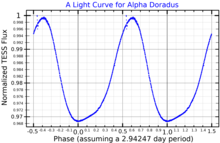Alpha Doradus, Latinized from α Doradus, is the brightest star in the southern constellation of Dorado. The distance to this system, as measured using the parallax method, is about 169 light-years (52 parsecs). [6]

This is a binary star system [9] with an overall apparent visual magnitude that varies between 3.26 and 3.30, [4] making this one of the brightest binary stars. [12] The system consists of a subgiant star of spectral type B revolving around a giant star with spectral type A in an eccentric orbit with a period of about 12 years. [2] [7] The orbital separation varies from 2 astronomical units at periastron to 17.5 astronomical units at apastron. The primary, α Doradus A, is a chemically peculiar star whose atmosphere displays an abnormally high abundance of silicon, making this an Si star. [8]
Alpha Doradus has an optical companion, CCDM J04340-5503C, located 77 arcseconds away along a position angle of 94°. It has no physical relation to the other two stars. [2] [13]
References
- ^ a b c HIP 21281, record for component 1, Hipparcos catalogue; CDS ID I/239.
- ^ a b c d e f g h i HR 1465, database entry, The Bright Star Catalogue, 5th Revised Ed. (Preliminary Version), D. Hoffleit and W. H. Warren, Jr., CDS ID V/50. Accessed on line September 3, 2008.
- ^ a b c HIP 21281, record for component 2, Hipparcos catalogue; CDS ID I/239.
- ^ a b alf Dor, database entry, The combined table of GCVS Vols I-III and NL 67-78 with improved coordinates, General Catalogue of Variable Stars Archived 2017-06-20 at the Wayback Machine, Sternberg Astronomical Institute, Moscow, Russia. Accessed on line September 3, 2008.
- ^ a b V* alf Dor -- Variable Star, database entry, SIMBAD. Accessed on line September 3, 2008.
- ^ a b van Leeuwen, F. (November 2007). "Validation of the new Hipparcos reduction". Astronomy and Astrophysics. 474 (2): 653–664. arXiv: 0708.1752. Bibcode: 2007A&A...474..653V. doi: 10.1051/0004-6361:20078357. S2CID 18759600.
- ^ a b "Entry 04340-5503", Sixth Catalog of Orbits of Visual Binary Stars, United States Naval Observatory, archived from the original on 2005-04-24, retrieved 2008-09-03
- ^ a b c d e f g North, P. (June 1998), "Do SI stars undergo any rotational braking?", Astronomy and Astrophysics, 334: 181–187, arXiv: astro-ph/9802286, Bibcode: 1998A&A...334..181N
- ^ a b c d e Kaler, James B., Alpha Dor, retrieved 2012-03-04
- ^ "MAST: Barbara A. Mikulski Archive for Space Telescopes". Space Telescope Science Institute. Retrieved 8 December 2021.
- ^ "alf Dor". The International Variable Star Index. AAVSO. Retrieved 2 July 2022.
- ^ Heintz, W. D. (April 1984), "Note on the orbit of alpha Doradus", The Observatory, 104: 88–89, Bibcode: 1984Obs...104...88H
- ^ "Entry 04340-5503, discoverer code HJ3668, components AB-C", The Washington Double Star Catalog, United States Naval Observatory, archived from the original on 2008-04-12, retrieved 2008-09-03
